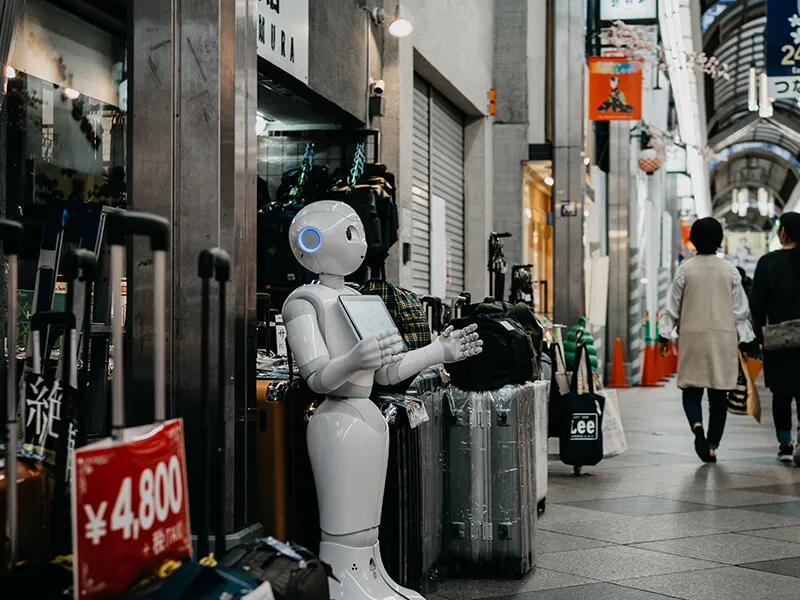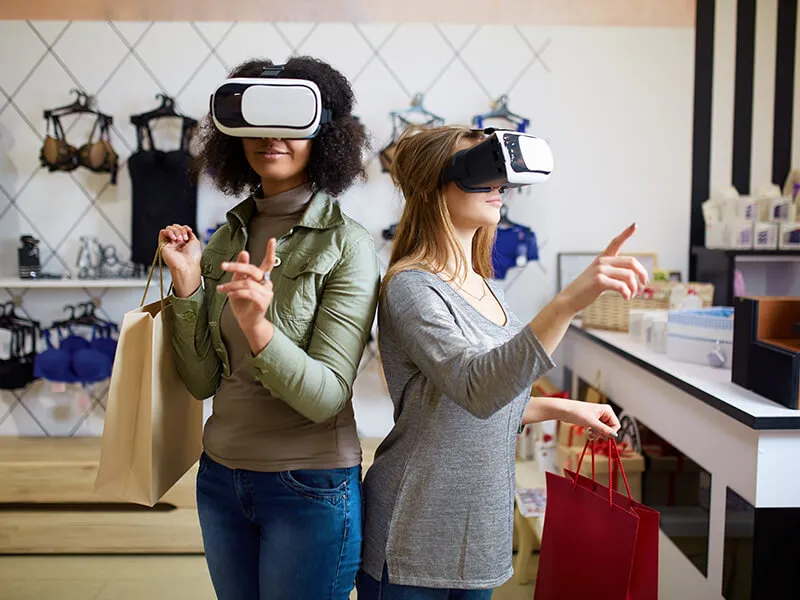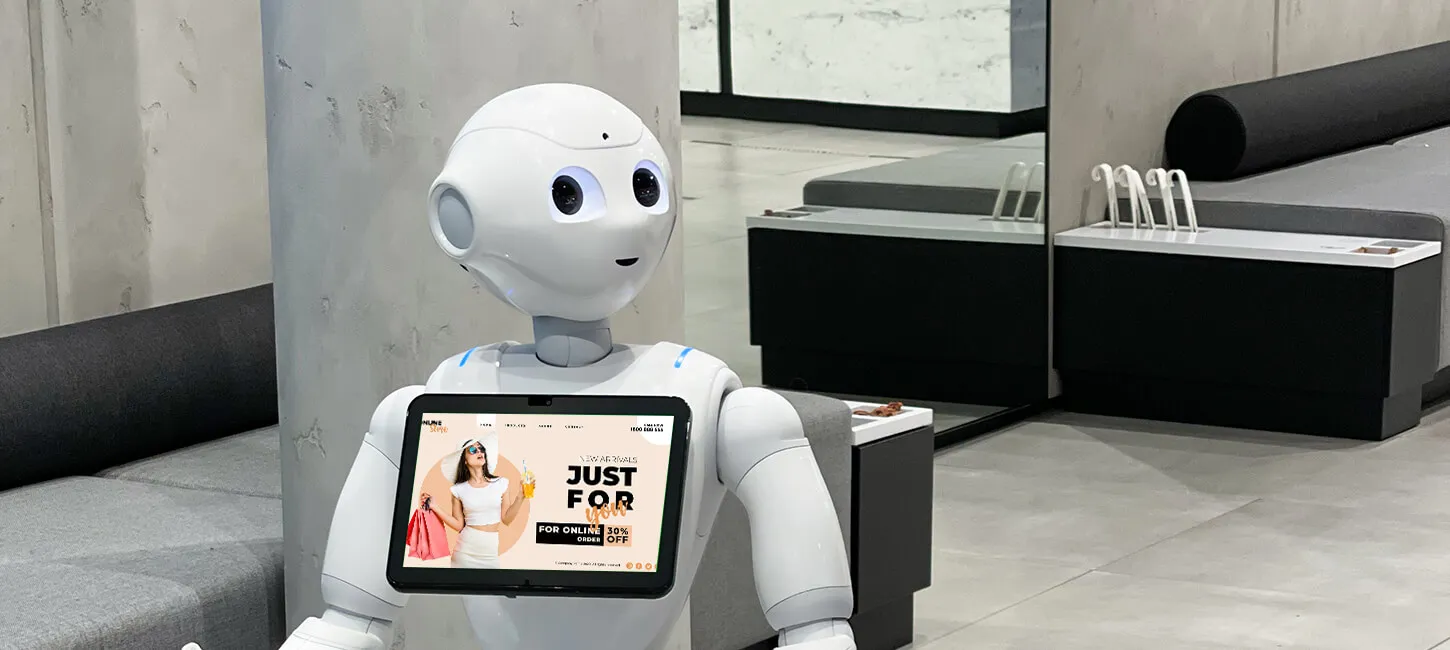Imagine a robot greeting you, on a good day, as you enter your favorite apparel store. While the other robot comes to guide you to the trial room, where your reserved Tuxedo Suit is awaiting your arrival.
Seems futuristic, right? Well, it is. We are here talking about the future of in-store experience that you will see in the coming times. With the advent of 5G technology and evolving needs for digital adaptability, shopping experiences worldwide have already witnessed tremendous change.
Followed by Covid-19, the planet witnessed another phase of transformation in terms of in-store shopping. People here were introduced to the progressive use of QR Codes where they could simply scan and understand the product’s information without the need for any in-person interaction with the executive.
Now, there’s yet another phase waiting for us – a much more advanced, convenient, and effective way of shopping. And what leads to such growth in terms of shopping experiences? The credit goes to the change in the shopping behavior of customers, changes in their demands, and even their expectations.
From the traditional one-to-one sell-purchase, manual demonstration, and billing queues, people across the globe are directly headed to robot-driven shopping. But, the road to such an enormous development is surely stacked with challenges that one needs to overcome. Let’s take a quick glance at such scenarios.
The journey of exceeding the milestones set in time for shopping experiences
You would surely be aware of the monotonous standards that the in-store shopping scenarios revolve around. But, herein, we are going to talk about the different milestones that one needs to achieve to provide their customers with exceptional shopping experiences.
To emulate online shopping experiences and entice customers to shop in person, in-store businesses are showing physical store enhancements. Conventional retail stores may now offer customers both the ease of online purchasing and the advantages of in-person shopping thanks to innovations like scan-and-go, limitless avenues, multichannel potential, and other such modern tech.
The future of in-store experience is headed a step further due to new potentials and innovations, both virtual and physical. Recent shifts in consumer behavior have led to new demands and rewards. Businesses have begun to embrace e-tailing after a rocky start. Consumer pleasure is not a retailer’s primary goal in this digitized, multichannel marketplace. The objective is to please the customer.
Each retailer now has to be a technology company because of the digital upheaval. Retailers are being forced to use technologies by the rapidly evolving digital industry in order to meet client needs and outpace rivals. The retail sector will undergo more upheaval in the forthcoming five years than it has done in the previous 50 years. The success of major retailers will depend on how they handle this transition.
The challenges that you need to encounter

Workforce Distribution:
Store-owners that long for digitalization come across the barrier of evenly aligning their workforce across departments, tasks, and platforms. One benefit of in-store purchasing is the knowledge and engagement of store employees. Having the right amount of personnel at the appropriate moments and in the right places is a concern for merchants. Understaffing might result in unhappy customers while overstaffing raises operating costs. Another difficulty that the future of in-store experience faces is forecasting seasonal fluctuations if more or fewer staff are required at specified periods during the year.
Demand Prediction:
Having the appropriate goods in the proper proportion at the ideal time is a matter of concern for the business operators. Stores use discounted prices to shift products when they are overloaded. Consumers may not come to stores if they are understocked because they are dissatisfied with the choices. Both options result in a loss of revenue.
Exchanges, Shrinkages, and Sluggish Checkout:
Buyers may rely on online retailers due to the hassle of exchanging or returning goods when a shop is not conveniently placed. In an in-store retail environment, stealing cannot be totally eliminated. Both employee skimming and shoplifting are considered forms of theft. Rather than enduring long retail lineups, customers choose to buy online. But, no worries! The future of in-store experience has exceptional solutions that would draw out the challenges relating to such shrinkages and checkout.
High Operational Expenses:
Retail business in a desirable area will probably draw greater footfall, but it will cost more money. Hence, it is seen as one of the major challenges for store-owners to encounter. Lessening the appeal of the location to save cash by renting or owning could result in a decline in foot traffic. Another pricey but crucial factor in luring them inside is offering hassle-free and convenient parking.
Personalization:
Another challenge that the store-owners usually come across is implementing the aspect of personalization in their selling activities. Personalizing things as per the consumer’s tastes and preferences works as a great motivator for them to visit the store again.
Proper customization as per the taste and preferences of the customers is the most important thing when it comes to the future of in-store experience. Modern-day shoppers prefer a specialized variety of goods that suit their requirements. This is in contrast to the old generation customers who considered buying whatever was available to them. Retailers must determine the unique demands of their customers and work to advertise their goods to those shoppers.
Exceptional Quality:
Who does not like to receive more quality at less price? This has been a general barrier in the arena of traditional stores that has been faced for a long time. Customers now anticipate “worth the money” instead of “reasonably priced.” Today, many buyers choose commodities based on factors other than just cost, such as authenticity, originality, or status.
Planning to deliver all together
a new & modern shopping experience to your consumers?
The journey from human-operated to technology-operated stores

Contextualization:
Businesses looking for modernization face the barrier of aligning employees and consumer data. This further hampers the development that shopkeepers could gain by keeping a close track of data that shows what the consumer actually desires. Individualized communications can no longer be created using only consumer segments. Solutions of today take advantage of dozens of parameters at the level of the specific customer. Retailers may entice, upsell, and cross-sell to very precise clientele while increasing retention by using Artificial Intelligence (AI) and Machine Learning. Using this new strategy, conventional merchants could be able to take on online and offline superstores like Amazon and Walmart.
Geofencing and Beacons:
The use of technology to locate and connect with prospective customers nearby a shop can increase footfall. Talking about Beacons, which are discrete wireless transmitters that communicate with neighboring smart devices using low-energy Bluetooth connection.
They are among the most recent advancements in proximity marketing and location technologies. Simply put, they link to smart devices and send data, facilitating and improving location-based search and engagement.
Beacons can convey customized deals and information about the shop, collect information on customer traffic, and organize staffing and workflows. In order to enhance aisle design and shop layout, this technology also assists in gathering feedback from customers and monitoring customer activity within the shop.
Infinite Avenue:
The appearance of an infinite aisle is given by in-store kiosks where clients can purchase items that are either out of stock or available only online. In order to provide practically infinite stock, shops collaborate with fulfillment providers, going to have to compete with digital hypermarkets. The never-ending aisle blends the ease of shopping online with the speed of in-store shopping. This dictates one of the major aspects while transitioning towards the future of in-store experience.
Social Media:
Hanging on to the clutches of social media to enhance the customer’s shopping experience is surely a difficult task to do for conventional shop-owners. Today’s modern mobile-driven market craves quick and regular interactions with merchants, which social media makes possible. With social media, businesses can establish two-way relationships with their clients by sharing information and collecting immediate responses. Businesses can also utilize social media to entice customers into retail stores.
Smart Carts:
One of the other developments that the store-owners look towards is the inculcation of advanced techniques such as barcode scanning. Consumers can scan the barcodes on the things they add to or remove out of their cart using Radio Frequency Identification (RFID) scanners and sensor-enabled smart carts. Clients and retailers both can gain from smart carts in a plethora of ways:
Smart Fitting Room:
Smart Fitting Room innovation allows consumers to receive the things they want while providing store staff with vital information. When a consumer enters the smart fitting room with clothing to put on, RFID scanners capture the product information and show them, together with extra size, color, and style alternatives, on a smart screen embedded into the changing room mirror. The consumer can then use a smart device to make a sales assistant an electronic request for help or more merchandise. In response to the request, the employee locates the desired items in the store via RFID and the smart device once more.
No Checkout and Self-Checkout:
By providing convenient and quick techniques to scan, pack, and pay for things, scan-and-go technology facilitates the shopping experience. With applications that interface with retail shelves and cams, detecting when items are taken off a shelf and loaded in a cart or set back on the shelf, no checkout is now feasible.
The future of in-store experience brings to us the sub-advantages of smart carts where the entire bill is automatically transferred out of the user’s app wallet when they exit the store. These more sophisticated checkout alternatives help consumers save time and effort. Minimal space and lesser personnel can be devoted to the checkout process by shopkeepers. By doing away with the cashier, shrinkage is reduced and cost correctness is guaranteed.
POS & Omnichannel Experience:
Mobile alternatives, cloud-based solutions, and systems that support cutting-edge payment options like Apple Pay and contactless cards via near-field communication are all part of the point-of-sale (POS) latest tech. The features included in POS programs differ. On the other hand, the advantages of traditional and online retail environments are combined in omnichannel prospects. Moreover, the ability to communicate with a business across various platforms is what entices both the consumer and the merchant.
Ready to provide services to your today’s consumers?
Check out the transformation brought up for the in-store shoppers

AR/VR Infused Shopping Experience:
Retail stores remain extremely significant and are expected to meet the ever-rising demands of consumers. The ability of the business to provide a linked omnichannel buying experience, such as accepting refunds of online items, is essential in this scenario, as is the provision of good customer services by well-trained front-line workers. Shops must promote a culture that values customer service. For instance, a location where clients may collaborate with professionals and technologies to co-create items.
In essence, customers may now bring their personal concepts to life and test them by utilizing 3D visualization and virtual or augmented technologies. This fresh viewpoint is being introduced to the timepiece industry by Baume, the newest brand to join the Richemont family. They developed a 3D configuration tool backed by 3D Visualization and Augmented Reality to allow customers to build their own dream watch in 3D by selecting anything from straps to hands, dials, casings, and inscription from a sum of over 2,000 different permutations. This was done in order to display its highly configurable collection of high-end product lines.
Check out a few AR/VR in-store shopping experiences here:
AR/VR-Based Product Demonstration
One renowned business that invests in AR/VR-Based Product Demonstration is IKEA. Customers are encouraged to visually equip complete rooms with a variety of IKEA products using the new IKEA Studio application. IKEA has facilitated such Augmented Reality-assisted sales to make it simpler for clients to accomplish their intended objective of The Wholesome Space.
BOPIS (Buy Online Pickup In-Store) Fulfillment Centers
Major retailers will probably continue to function as BOPIS (Buy Online Pickup In-Store) fulfillment facilities as e-commerce expands. Retail sales representatives from upscale firms like Tiffany’s are already using their individual social media profiles to market to their own online communities. Prominent influencers who conduct tours of various stores and reserve retail studios similar to concert venues may also become more prevalent.
Click and Collect Buying Experience
74 percent of shoppers said they like to research products online before making in-store purchases. In addition, 64 percent of respondents indicated that they wanted more fulfillment options and believed it was critical that a brand or shop offer Click and Collect. Does this not give you a better understanding of what the future of in-store experience beholds?
But not only this, there was a definite age divide here as well. 67% of those between the ages of 16 and 24 years wanted a Click and Collect option, compared to 43% of those over the age of 55 years. Intriguingly, 66.6% of consumers aged 16 to 24 years say they consider the accessibility of Click and Collect services when making purchases online, compared to 42.9% of consumers over the age of 42 years.
Omnichannel Experience For Shoppers
To make your shoppers live an omnichannel experience is to stay present for the consumers and offer them a personal shopping experience. The opportunity to touch and try on things tops among the three highly desired aspects of in-store fashion buying. Secondly, they desire to purchase right away, without having to wait or pay shipping fees, and finally, they want a cutting-edge, immersive store atmosphere with features like demos, a virtual changing room, or in-store gatherings.
It could thus be inferred that the omnichannel experience for shoppers could fulfill any and everything that the present-day consumer desires.
A sizable chunk of customers indicated an interest in hybrid multichannel in-store experiences as they looked toward the future. According to one of the studies, shoppers favored tailored promotions, scan-and-pay, demos, exhibitions, and activities for in-store visits, as well as augmented reality experiences with product details and digital incentives.
Retailers want digital solutions that can fit easily into their systems, are cost-effective, and reduce the requirement for extensive employee training in order to take advantage of these prospects. Employees may assist customers to get over some of their greatest turnoffs by having quick, on-the-spot access to current data by collecting information from barcodes, placards, or stacks.
The Future of In-Store Experience Goes The Digital Way
We are now in a digital environment where there is no longer a distinction between the physical and digital environments in retailing but instead a world that is entirely interconnected. We believe that in 2030 when a customer enters a business, they will feel truly connected;i.e, they will experience positive feedback from social networks or from relatives and friends who are not even close by. The face of the shopping experience will revolutionize at an individual level by 2030. In the future, shopping in-store would feel more like the customer is shopping with close friends or perhaps even a personal stylist.
A step-wise guide to inculcate online in-store experience for customers

Organize The Data Feeds You Use:
There are various methods for contacting your clients in the modern digital environment. From platforms such as Instagram and Facebook to online stores like Amazon, the future of in-store experience has backed it all. However, managing your information across platforms and delivering a seamless experience can be difficult, which is why you should spend money on a solution that optimizes your streams of data.
You can publish real-time product modifications throughout all of your channels via a consolidated data feed, ensuring that clients never unintentionally add an out-of-stock item to their shopping baskets.
A centralized data solution can help you optimize ad expenditure across platforms, identify whether advertisements contain non-converting phrases, and cater the visuals in a single feed to various consumers. In essence, an intelligent feed management system enables you to personalize your marketing strategy while preserving your brand recognition across many channels, including online and offline ones.
The In-Store Experience Should Be Digitized:
Consumers who made in-store purchases frequently began their purchasing processes online even before the outbreak. Before going to the store to make their purchases, they would do their research on the items they were interested in. We’ll probably see a return to this trend as consumers become more accustomed to in-person purchasing, which opens up new possibilities for digital in-store interactions.
Suppose the following: A customer finally decides to visit your business after checking a product on your website. Your app sends the customer notification for a flash sale offering 15% off while they’re still standing close to it. Such data-driven alerts can encourage customers to make purchases. This is nothing but a tiny part of the future of in-store experience that makes a huge difference. This is becoming a reality in no time, all thanks to data-driven marketing.
Publish Regional Inventory Advertising:
Local inventory advertising offers a solution for retailers who are having trouble offsetting their excess inventory. If your company has a structured data feed, you can leverage store-specific stock levels to advertise surplus goods to local customers. These kinds of advertisements are essential for encouraging both in-store collections and the sale of overstock items.
Additionally, localized inventory advertisements provide customers the option to connect through product descriptions on your web and discover useful details like your opening times, location, and current specials.
Click-and-Collect Can Boost Footfall:
Now is the best time to adopt BOPIS (buy online, pick up in-store) solutions. These products combine in-store and online purchasing. You may persuade your clients to take the first step towards returning to your physical business by providing a seamless online buying platform that allows in-store pickups at checkout. Additionally, there’s a probability they’ll make additional purchases inside if they’re currently at your site.
The Final Lines:

So, what stands to be our final call? Put simply, we bet on maintaining an edge over the competition by taking small steps towards the future of retail shopping. At each and every phase of the customer journey, businesses can combine data insights into customization initiatives by utilizing improved search functionality and machine-learning techniques.
It is necessary to clearly acknowledge that the future of in-store experience is quickly ensuing. 71% of today’s modern shoppers want personalized service. Maintaining an edge over the competition will help your company stand out.
This implies that retailers are considering ways to personalize the overall client journey more and more. Organizations must mix several kinds of data to adopt a comprehensive perspective in order to provide a consistent experience that communicates to each consumer as an individual.


